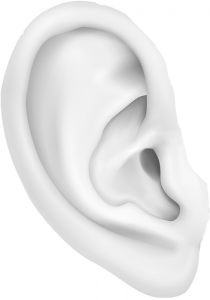Sometimes it represents a serious, life threatening disease
By Eva Briggs
 Most people assume that when their ear hurts, it must be an infection. But otalgia — the technical term for ear pain — can stem from an assortment of conditions. Sometimes the cause is primary, due to problems with the ear itself. Other times, the pain is secondary to a problem in another part of head, neck or even chest.
Most people assume that when their ear hurts, it must be an infection. But otalgia — the technical term for ear pain — can stem from an assortment of conditions. Sometimes the cause is primary, due to problems with the ear itself. Other times, the pain is secondary to a problem in another part of head, neck or even chest.
How can it be that problems with other body parts can cause ear pain?
Think of hearing a noise and being able to determine the general direction but not the exact source of the sound. Sometimes the same thing happens in the part of the brain that detects pain. The pain center senses that that a particular nerve is broadcasting a pain signal. But there’s a mix up because a single nerve may extend to several anatomical structures. The brain mistakenly assigns the pain to the ear even though it started someplace else.
For example, the trigeminal nerve connects to the face, sinuses, and teeth. The facial nerve receives input from the tongue and soft palate. The glossopharyngeal nerve serves the tongue, tonsils, pharynx, and middle ear. The vagus nerve senses signals from the heart, lungs and gastrointestinal tract.
Primary ear pain, originating in the ear itself, can arise from infection. Infection in the middle ear, otitis media, is the familiar earache common in small children. Otitis externa, often called swimmer’s ear, involves the ear canal. The outer part of the ear, or auricle, can also be infected. A common noninfectious form of ear pain is eustachian tube dysfunction, a failure to equalize the pressure between the atmosphere and the middle ear.
Other less common causes of primary ear pain include mastoiditis (infection of the air cells contained in the bones adjacent to the ear), shingles affecting ear structures, relapsing polychondritis (noninfectious cartilage inflammation), tumors, infected cysts, and injury. That’s only a partial list!
When it comes to secondary ear pain, the possibilities are multiple. Common causes include sinus and dental infections. Pain can originate in the joint between the temple and the mandible, TMJ syndrome.
Sometimes ear pain represents a serious, life threatening disease. While pain from a heart attack typically is in the chest, neck, arms or upper abdomen, a few people experience the pain in the ear.
Clues to the real cause include associated symptoms like sweating, nausea, palpitations or shortness of breath. There might also be signs like an abnormal pulse or blood pressure.
Temporal arteritis, a type of inflammation of the blood vessels, can present as ear pain. The pain might be worse with chewing, because the inflamed artery can’t provide enough blood flow to the chewing muscles. This disorder requires immediate treatment because it can block blood flow to the eyes and cause permanent blindness.
With so many potential causes of ear pain, you’ll need to see a healthcare provider who can perform a careful history and exam to identify the cause and the proper treatment.
Eva Briggs is a medical doctor who works at two urgent care centers (Central Square and Fulton) operated by Oswego Health.

